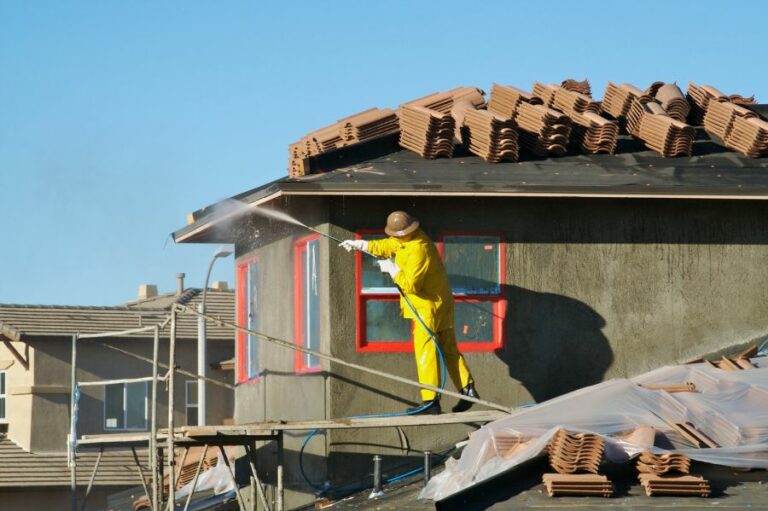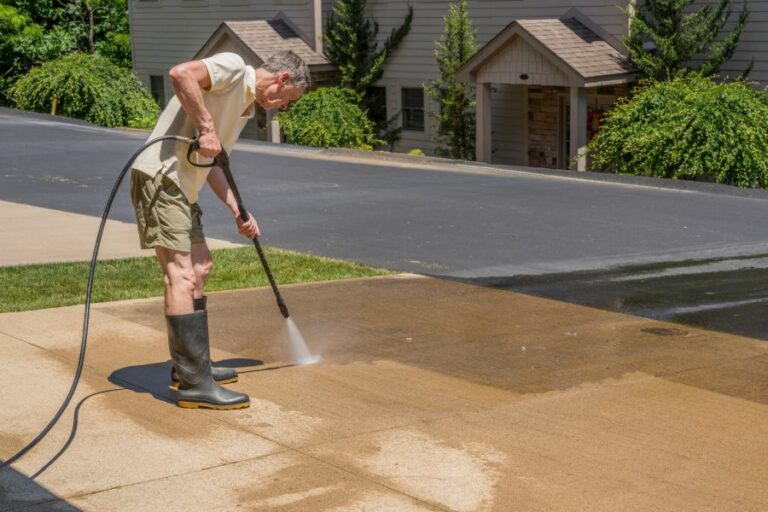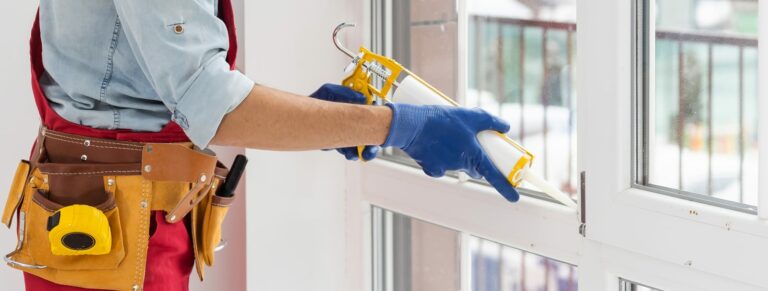Tips For Using Wire Brushes On Surfaces. What Pros Say
Tackling a project that requires a wire brush to clean or restore surfaces can be intimidating, but we’ve got you covered! The key to success is selecting the right brush and technique. With expert tips in your arsenal, you’ll be equipped to achieve impressive results showcasing your craftsmanship.
Tips for using wire brushes on surfaces:
Choose the right brush material and type for the specific task when using wire brushes on surfaces. Maintain a consistent angle and use light pressure to maximize effectiveness. Clean the brush regularly and follow safety precautions, such as wearing goggles and gloves. Lubricate steel brushes and inspect them frequently for signs of wear.

Ready to make your surfaces shine? Discover expert tips for using wire brushes effectively on various surfaces, including choosing the right brush, safety measures, and techniques for optimal results. Keep reading to master this essential cleaning and refinishing skill!
Contents
- 1 Wire Brush Usage Tips for Various Surfaces
- 2 Essential Safety Guidelines for Wire Brush Use
- 3 Suitable Materials for Wire Brush Application
- 4 Ideal Surfaces for Wire Brush Prep Work
- 4.1 • Metal Surfaces: Removing Rust and Paint
- 4.2 • Masonry and Concrete Surfaces: Cleaning and Surface Preparation
- 4.3 • Wooden Surfaces: Stunning Stripping and Cleaning Results
- 4.4 • Removing Weld Spatters and Slag
- 4.5 • Wire Brushes and Grilled Surfaces
- 4.6 • Tips for Using Wire Brushes Effectively and Safely
- 5 Is It Safe to Use a Wire Brush on Wooden Surfaces?
Wire Brush Usage Tips for Various Surfaces
Wire brushes are versatile tools used for various purposes like surface cleaning, rust removal, deburring, and more. To achieve the best results and ensure the longevity of the brush, it is crucial to use the right technique.
• Choosing the Right Wire Brush
The first step in using wire brushes effectively is selecting the right brush for the specific purpose. There are various factors to consider, such as wire size, material, and the type of brush.
– Wire Material
The most common wire materials used in brushes are steel, brass, and stainless steel. Each material offers unique advantages and is suitable for specific applications.
- Steel wire brushes are strong and durable, making them ideal for removing rust and paint from metal surfaces. However, they should not be used on softer materials like aluminum, as they can cause damage.
- Brass wire brushes are softer than steel, making them suitable for cleaning delicate surfaces like copper, brass, and aluminum without causing damage.
- Stainless steel wire brushes offer corrosion resistance and can be used on stainless steel, aluminum, and other non-ferrous metals.
– Brush Type
There are various types of wire brushes, including cup brushes, wheel brushes, and end brushes. Choose the brush type based on your specific requirements and the surface you are working on.
- Cup brushes are ideal for flat surfaces and can easily remove rust, paint, and other debris.
- Wheel brushes are suitable for cleaning grooves and edges, thanks to their circular shape.
- End brushes work well for small, hard-to-reach areas and detailed work.
• Proper Handling of Wire Brushes
To achieve optimum results and prevent damage, follow these tips for handling wire brushes:
– Maintain a Consistent Angle
When using a wire brush, maintain a consistent angle between the brush and the surface. A shallow angle is often more effective in removing rust and debris, while a steep angle can cause the brush to “dig” into the surface.
– Use Light Pressure
Applying excessive pressure can cause the wire bristles to break, reducing the lifespan of the brush. Instead, use light pressure and allow the brush to do the work.
– Clean the Brush Regularly
Regularly cleaning your wire brush will help remove debris and ensure its effectiveness. Tap the brush on a hard surface to dislodge trapped particles, or use a brush comb to clean between the bristles.
• Safety Precautions
When working with wire brushes, always follow these safety precautions to prevent injuries:
- Wear safety goggles to protect your eyes from wire bristles and debris.
- Use gloves to protect your hands from cuts and abrasions.
- Ensure that the brush is securely attached to the tool you are using, such as a drill or angle grinder.
- Keep your work area clean and well-ventilated to minimize dust and fume inhalation.
- Follow the manufacturer’s recommendations for maximum RPM when using a brush with a power tool.
• Additional Tips
- For better performance and longer brush life, lubricate steel wire brushes with a light oil or rust inhibitor. This can help reduce wire breakage and keep the brush in good condition.
- Inspect your wire brush frequently for signs of wear or damage, such as broken or loose bristles. Replace the brush if necessary to prevent injuries or damage to the surface you are working on.
- Always test the brush on a small, inconspicuous area of the surface before proceeding with the main task. This will allow you to assess the brush’s effectiveness and prevent potential damage to the primary surface.
- Alternate between using a wire brush and a softer brush or cloth to remove debris and polish the surface. This will help maintain the surface’s smoothness and shine.
In conclusion, using a wire brush effectively requires selecting the right brush, maintaining proper handling techniques, and following safety guidelines. Implementing these tips will help you achieve the best results and extend the lifespan of your wire brushes.
Essential Safety Guidelines for Wire Brush Use
Wire brushes are versatile and highly effective tools for cleaning, polishing, and surface preparation across various industries. However, they can also pose significant risks to operators if not handled properly.
• Use the Right Wire Brush for the Job
Selecting the appropriate wire brush for your task is crucial for both achieving the desired result and ensuring the operator’s safety. There are multiple types of wire brushes available, including wheel brushes, cup brushes, end brushes, and tube brushes.
Each type has its specific application, and using the wrong one may lead to malfunction and possible injury. It is essential to consult the manufacturer’s guidelines or an experienced professional to choose the right wire brush for your task.
• Inspect and Maintain Your Wire Brushes
Before using a wire brush, always conduct a thorough inspection to check for any signs of damage or wear. Look for broken, loose, or excessively worn wires, as they can become projectiles and cause injury. Replace worn-out brushes promptly, as damaged brushes are more likely to break apart during use.
When working with power-driven wire brushes, be sure to inspect and maintain the power equipment. Keep the tool and power cord in good condition and ensure that all safety features, like guards and handles, are correctly installed and functioning.
Regular maintenance of your wire brushes will prolong their life and minimize the risk of accidents.
• Wear Proper Personal Protective Equipment (PPE)
Wearing appropriate personal protective equipment is crucial while working with wire brushes. The following PPE items are highly recommended when using wire brushes:
- Safety glasses or goggles: They protect your eyes from flying debris and wire filaments.
- Face shield: A full-face shield provides additional protection against flying particles and should be worn over safety glasses or goggles.
- Gloves: Wear sturdy work gloves to protect your hands from cuts, punctures, and abrasions during wire brush use.
- Hearing protection: Use earplugs or earmuffs to protect your hearing if working with noisy power-driven wire brushes.
- Appropriate clothing: Wear long sleeves, long pants, and closed-toe shoes to minimize skin exposure to flying debris.
• Follow Safe Operating Procedures
When using a wire brush, it is crucial to follow safe operating practices to minimize the risk of injury. Some general guidelines include the following:
- Ensure proper workpiece fixation: Secure the workpiece firmly using suitable holding devices like clamps or vises to ensure that it does not move during the brushing process.
- Use the correct speed: For power-driven wire brushes, always operate the tool at the recommended speed specified by the manufacturer. Operating at excessive speeds can cause the brush to break apart and lead to accidents.
- Work in a well-ventilated area: Adequate ventilation is essential to minimize the inhalation of dust and other airborne particles generated during the brushing process.
- Avoid side pressure: When working with power-driven wire brushes, apply pressure only in the direction of brush rotation. Applying side pressure can cause the wire to break or the power tool to kick back.
- Steer clear of entanglement: Keep long hair, loose clothing, and jewelry away from the rotating brush to prevent entanglement.
- Stay alert: Always focus on the task at hand and do not use wire brushes when fatigued or under the influence of alcohol or drugs.
• Train Operators on Proper Wire Brush Use
Ensure that all operators are trained in the correct and safe use of wire brushes. Training should include information on proper brush selection, inspection and maintenance procedures, safe operating practices, and the use of personal protective equipment.
By adhering to these safety precautions, you can effectively use wire brushes while minimizing the risk of injury. Remember, safety comes first. It not only protects you but also makes the job more efficient and enjoyable.
Precaution | Description |
|---|---|
Wear Safety Equipment | Wear safety goggles, gloves, and other protective clothing to avoid injury from flying debris or wire filaments. |
Inspect Wire Brush | Before using the wire brush, inspect it for any damage, missing bristles, or other issues that may cause injury or impact performance. |
Use Appropriate Speed | Always follow the manufacturer’s recommendations for the maximum RPM and ensure the brush is used at the appropriate speed to avoid accidents. |
Secure Workpiece | Always secure the workpiece using clamps or a vice to ensure it does not move during the brushing process, which could cause injury or damage to the material. |
Maintain Proper Technique | Use both hands to control the tool, and always brush away from your body, maintaining a safe distance between the brush and your body to avoid injury. |
Keep A Clean Workspace | Keep the area around the wire brush clean and free of debris to minimize the risk of accidents or interference during the brushing process. |
Planescape Tool Storage | Store wire brushes and other tools properly when not in use to prevent accidents and damage to the bristles or other components. |
Suitable Materials for Wire Brush Application
• Understanding Wire Brushes
Wire brushes are versatile and essential tools used in a wide range of applications. These tools consist of stiff, metal bristles attached to a handle or base, designed for various purposes such as cleaning, deburring, and surface preparation.
Wire brushes come in a variety of sizes, shapes, and materials, allowing them to be used in various industries such as automotive, manufacturing, and construction.
• Common Wire Brush Applications
– Cleaning
One of the most common uses of wire brushes is cleaning away dirt, grime, and rust from different types of surfaces. Some examples include:
- Automotive Components: A wire brush can help remove accumulated dirt, grease, and rust from car parts like brake calipers, exhaust pipes, and engine parts.
- Outdoor Equipment: Wire brushes prove to be effective in cleaning gardening tools, barbecue grills, and patio furniture.
- Flooring Surfaces: Wire brushes are used to clean and restore the appearance of concrete, brick, and wooden floors.
– Surface Preparation
Before applying paint, coatings, or adhesive materials, it is essential to have a clean, roughened surface to promote proper adhesion. Wire brushes can be used for:
- Paint Removal: A wire brush effectively removes peeling or flaking paint, allowing a new coat of paint to adhere correctly.
- Rust Removal: Wire brushes help eliminate rusty surfaces before applying a rust-resistant coating or before welding.
- Adhesion Promotion: A wire brush can roughen a surface, facilitating proper adhesion of paint, glue, or other binders.
– Deburring and Edge Cleaning
Wire brushes are beneficial in removing burrs, the raised edges, or small pieces of material remaining after cutting, grinding, or drilling from different materials. Some examples include:
- Metalwork: Wire brushes can remove burrs left from cutting or shaping various metals, such as aluminum, steel, or copper.
- Woodworking: Wire brushes help clean and smooth wooden edges by removing splinters or rough spots.
- Plastic Fabrication: Wire brushes can eliminate burrs and rough edges on plastics after cutting or molding.
• Selecting the Right Wire Brush
To ensure the best results, it is crucial to choose the right wire brush for the specific task. Factors to consider when selecting a wire brush include:
– Bristle Material
Wire brushes come with different types of bristles, each designed for particular applications:
- Steel Wire: Steel wire brushes are ideal for general-purpose cleaning and surface preparation on iron, steel, and other ferrous metals.
- Stainless Steel Wire: Stainless steel wire brushes are recommended for cleaning and surface preparation on stainless steel, aluminum, and other non-ferrous metals, as they prevent contamination and potential rust.
- Brass Wire: Brass wire brushes provide gentle, non-sparking cleaning, making them suitable for use on softer materials or in environments where sparks may be hazardous.
– Brush Shape and Size
Different wire brush shapes and sizes are designed for specific applications:
- Cup Brushes: Cup-shaped wire brushes are best for cleaning larger flat surfaces, deburring edges, and rust removal.
- Wheel Brushes: Wheel brushes are ideal for surface preparation, edge blending, and cleaning confined areas.
- End Brushes: End brushes feature bristles at the tip of the tool and are suited for cleaning tight spaces or localized surface preparation.
– Attachment Types
Wire brushes can be used as hand-held tools or power tool attachments, depending on the application:
- Hand-Held Brushes: Hand-held brushes are ideal for cleaning smaller surfaces and intricate parts that require manual control.
- Power Tool Attachments: Power tool attachments like a drill or angle grinder-mounted brushes provide efficient cleaning, preparation, or deburring on larger surfaces or when a significant amount of material needs to be removed.
• Conclusion
Wire brushes are versatile and essential tools used for cleaning, surface preparation, and deburring applications across various industries.
By understanding the different types of wire brushes and their applications, users can select the most appropriate tool for their specific tasks, ensuring optimal efficiency and results.
Item | Use |
|---|---|
Grill | Cleaning and removing food residue |
Rusted metal surfaces | Removing rust and corrosion |
Automotive parts | Cleaning and maintaining engine components |
Painted surfaces | Stripping paint and preparing the surface for repainting |
Masonry work | Removing loose mortar and cleaning brick or stone surfaces |
Ideal Surfaces for Wire Brush Prep Work
Wire brushes are invaluable tools when it comes to surface preparation or removing rust, paint, and other residues from various surfaces. Given their versatility, they can work on different materials and types of surfaces.
• Metal Surfaces: Removing Rust and Paint
Wire brushes are perhaps best known for their ability to remove rust and paint from metal surfaces. These can include both large structures, such as bridges and vehicles, and smaller objects like tools, machinery, and metal furniture.
– Recommendation: Choose the Right Wire Brushes
Based on the hardness of the metal, choosing a suitable wire brush is crucial. For instance, brass brushes work well on softer metals like brass, copper, or aluminum. Meanwhile, steel or stainless-steel brushes are suitable for harder metals like iron, steel, or stainless steel.
• Masonry and Concrete Surfaces: Cleaning and Surface Preparation
Wire brushes are ideal for cleaning masonry and concrete surfaces, such as patios, sidewalks, walls, and floors. They effectively remove dirt, moss, algae, old paint, and other contaminants from the surface. Furthermore, wire brushes can also help prepare concrete surfaces for painting by roughening them.
– Recommendation: Use Wire Brushes with Care on Decorative Masonry
While using a wire brush to clean decorative masonry or historical brickwork, be cautious to avoid damaging the surface. Opt for softer, less aggressive brushes and carefully test a small, inconspicuous area first.
• Wooden Surfaces: Stunning Stripping and Cleaning Results
Wire brushes can also be used on wood to produce stunning results. These versatile tools are excellent at removing old paint, stain, or varnish, and they can even create an aged or distressed appearance.
– Recommendation: Choose a Less Aggressive Brush for Delicate Wood
When working on softer or more delicate wood, select a brass or nylon brush to avoid causing damage. Always test on a small, hidden area before carrying out major work.
• Removing Weld Spatters and Slag
A wire brush acts as an indispensable tool for welders, particularly for cleaning and preparing surfaces before welding. They efficiently remove oxidation, weld spatters, slag, and other residues, helping create a clean work environment and ensure strong welds.
– Recommendation: Match Wire Brushes with the Metal Being Welded
When selecting a wire brush for welding, it is essential to match the brush material with the metal being welded. Generally, it’s advised to use a stainless-steel brush when dealing with stainless steel and a regular steel brush for carbon steel.
• Wire Brushes and Grilled Surfaces
Keeping grills and barbecues clean is crucial for safety and hygiene. Wire brushes can effectively remove charred residues, grease, and grime, ensuring delicious and safe cooking experiences.
– Recommendation: Regularly Check the Condition of Grill Brushes
It is essential to regularly inspect your wire grill brush to avoid ingesting loosened bristles while eating. Seek replacements if you notice loose or dislodged bristles.
• Tips for Using Wire Brushes Effectively and Safely
To get the best results and ensure safety, it is vital to follow some simple best practices when using wire brushes:
- Protect Your Eyes and Skin: Always wear safety glasses and gloves to avoid injuries from flying debris and wire bristles.
- Choose the Right Tool: Pick the right wire brush based on factors such as the strength and size of the bristles and the material of the surface you’re working on.
- Maintain Your Wire Brushes: Store wire brushes in a dry location and monitor them for excessive wear or damaged bristles, replacing them when necessary.
- Use Proper Technique: Always brush parallel to the surface to avoid damaging it. Apply sufficient pressure, but not so much that it strains the bristles or the surface being cleaned.
In conclusion, wire brushes are versatile tools for many applications, ranging from metal, wood, concrete, and masonry surfaces to weld cleaning and grill maintenance.
By following the recommendations and tips mentioned in this article, you can make the most of these indispensable tools while ensuring long-lasting and effective results.
Is It Safe to Use a Wire Brush on Wooden Surfaces?
In short, yes, you can use a wire brush on wood. A wire brush is a versatile tool that can be extremely useful in preparing, cleaning, and maintaining wooden surfaces. However, it’s important to understand when to use a wire brush on wood and how to do it effectively without causing damage to the surface.
• Different Types of Wire Brushes
There are several types of wire brushes available, each designed for specific applications. Some common types include:
- Brass Wire Brushes: Made from brass, these brushes are softer than steel and are suitable for delicate wood surfaces or for prepping wood for staining or painting. Brass wire brushes are often used for cleaning, polishing, or removing light rust.
- Steel Wire Brushes: These brushes are made from steel and are sturdier and more aggressive than brass wire brushes. Steel wire brushes are suitable for rougher surfaces such as reclaimed wood or heavily weathered outdoor furniture.
- Stainless Steel Wire Brushes: Similar to steel wire brushes, stainless steel brushes are also aggressive but are more resistant to rust.
- Nylon Wire Brushes: These brushes have nylon bristles instead of metal, making them the most gentle option for cleaning and prepping wood surfaces.
Each type of wire brush serves a specific purpose, so it’s important to select the appropriate brush depending on the wood surface and the desired outcome.
• When to Use a Wire Brush on Wood
There are several situations when using a wire brush on wood can be beneficial:
- Cleaning and Stripping: Wire brushes can effectively remove dirt, grime, paint, or varnish from wooden surfaces.
- Distressing: If you want to create a weathered or rustic look on a wooden surface, a wire brush can help achieve the desired effect by removing softwood fibers and highlighting the wood grain.
- Preparation for finishing: A wire brush can prepare a wood surface for staining, painting, or sealing by creating a more even and uniform texture.
- Maintenance: Regular use of a wire brush on outdoor wooden furniture or decking can prevent the build-up of dirt and help maintain the wood’s appearance and longevity.
• Techniques for Effective Wire Brush Use on Wood
To use a wire brush effectively on wood and achieve the desired results, follow these guidelines:
- Choose the right brush: Select the appropriate wire brush depending on the wood’s hardness and the level of abrasion required.
- Apply even pressure: When using a wire brush, apply consistent and even pressure to avoid gouging or creating uneven surfaces.
- Brush in the direction of the grain: Always brush in the direction of the wood grain to achieve the best results and avoid cross-hatching, which can damage the wood surface.
- Use overlapping strokes: When brushing a large surface, use overlapping strokes to ensure complete and uniform coverage.
- Progress from coarse to fine: If you need to use different wire brushes to achieve the desired level of cleaning, start with a coarser brush and gradually move to finer brushes.
- Clean the surface afterward: After using a wire brush on wood, clean the surface with a cloth or vacuum to remove dust and debris.
• Personal Recommendations
Based on my experience, here are a few personal recommendations when using a wire brush on wood:
- For general cleaning or light paint removal, I recommend using a brass or nylon wire brush to avoid damaging the wood.
- For more aggressive cleaning or paint stripping, a steel or stainless steel wire brush may be more suitable.
- When working with softer woods, such as pine, it’s essential to use a gentle touch to avoid damaging the surface.
- Practice on a scrap piece of wood before working on your final piece to learn how the different brushes and techniques will affect the wood.
• Final Thoughts
Wire brushes can be a valuable tool in working with wood, whether for cleaning, preparation, or distressing.
By selecting the appropriate wire brush, applying the right techniques, and following the guidelines outlined in this article, you can use a wire brush on wood effectively and achieve the best possible results.
Always remember to work with caution and care to preserve the integrity and beauty of the wood surface.
| Can you use a Wire Brush on Wood |
|---|
| Yes, but with caution. Wire brushes can be used on wood to remove paint, rust, or dirt, and to create a distressed or weathered look. However, they can also cause damage to the wood surface, so use a softer wire brush and apply gentle pressure. |







